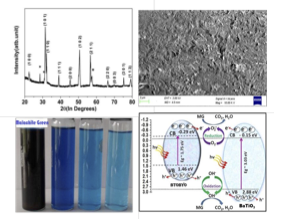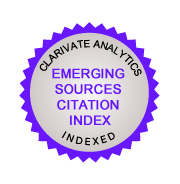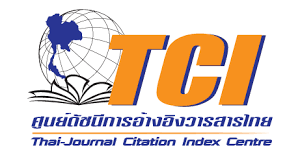Photocatalytic behaviour of (BiYbO\(_{3}\))\(_{0.5}\)-(BaTiO\(_{3}\))\(_{0.5}\)
DOI:
https://doi.org/10.55713/jmmm.v35i2.2232คำสำคัญ:
Rare Earth, Photocatalyst, Malachite green, Nanomaterialบทคัดย่อ
Different organic compounds like dyes and pharmaceutical contaminants pollute a large amount of water which can increase the chemical oxygen demand in water bodies. The photodegradation of dyes has been widely studied using TiO2-based nanomaterials, which are typical photocatalysts. TiO2 is highly effective in reducing pollutants when exposed to UV light and does not cause secondary pollution. However, TiO2 is only functional when exposed to UV light, which is not ideal for real-world use. This drawback of TiO2 pulls the research towards modified photocatalysts for better yield. In this study, the (BiYbO3)0.5 - (BaTiO3)0.5 material was formulated by solid state reaction technique. This material is crystallized to Tetragonal, P4mm. The nano-rod structure can be observed from the FESEM. The photo degradation behavior of the material is observed against the pollutant i.e. Malachite Green. It is found that the photocatalytic degradation of Malachite green is 92.2% in 60 minutes.
Downloads
เอกสารอ้างอิง
T. Badapanda, V. Senthil, S. Panigrahi, and S. Anwar, “Diffuse phase transition behavior of dysprosium doped barium titanate ceramic,” Journal of Electroceramics, vol. 31, no. 1-2, pp. 55-60, 2013. DOI: https://doi.org/10.1007/s10832-013-9808-x
A. Kumari, A. Vij, Mohd. Hashim, A. Dubey, and S. Kumar, “Enhancement in the dielectric properties of Sm doped BaTiO3 bulk ceramics,” presented at the The 3rd Joint International Conference On Energy Engineering And Smart Materials (Iceesm-2018) And International Conference On Nanotechnology And Nanomaterials In Energy (ICNNE-2018), Milan, Italy, 2018, p. 030012. DOI: https://doi.org/10.1063/1.5051268
M. Ganguly, S. K. Rout, W. S. Woo, C. W. Ahn, and I. W. Kim, “Characterization of A-site deficient samarium doped barium titanate,” Physica B: Condensed Matter, vol. 411, pp. 26-34, 2013. DOI: https://doi.org/10.1016/j.physb.2012.11.006
Z.Yao, H. Liu, Y. Liu, Z. Wu, Z. Shen, Y. Liu, and M. Cao, “Structure and dielectric behavior of Nd-doped BaTiO3 perovskites,” Materials Chemistry and Physics, vol. 109, no. 2-3, pp. 475-481, 2008. DOI: https://doi.org/10.1016/j.matchemphys.2007.12.019
M. Ganguly, S. K. Rout, T. P. Sinha, S. K. Sharma, H. Y. Park, C. W. Ahn, and I. W. Kim, “Characterization and rietveld refinement of A-site deficient lanthanum doped barium titanate,” Journal of Alloys and Compounds, vol. 579, pp. 473-484, 2013. DOI: https://doi.org/10.1016/j.jallcom.2013.06.104
Y. A. Zulueta, T. C. Lim, and J. A. Dawson, “Defect clustering in rare-earth-doped BaTiO3 and SrTiO3 and its influence on dopant incorporation,” Journal of Physical Chemistry C, vol. 121, no. 42, pp. 23642-23648, 2017. DOI: https://doi.org/10.1021/acs.jpcc.7b08500
M. M. S. Sanad, M. M. Rashad, E. A. Abdel-Aal, M. F. El-Shahat, and K. Powers, “Optical and electrical properties of Y3+ ion substituted orthorhombic mullite Y(x)Al(6−x) Si2O13 nanoparticles,” Journal of Materials Science: Materials in Electronics, vol. 25, no. 6, pp. 2487-2493, 2014. DOI: https://doi.org/10.1007/s10854-014-1900-8
M. Padhy, R. N. P. Choudhary, and P. G. R. Achary, “Effect of Bi and Sm ion doping in barium titanate ceramic: Dielectric, optical and ferroelectric study,” Applied Physics A , vol. 127, no. 11, p. 847, 2021. DOI: https://doi.org/10.1007/s00339-021-04990-z
P. Padmini, and T. R. N. Kutty, “Influence of Bi3+ ions in enhancing the magnitude of positive temperature coefficients of resistance in n-BaTiO3 ceramics,” Journal of Materials Science: Materials in Electronics, vol. 5, no. 4, 1994. DOI: https://doi.org/10.1007/BF00186186
M. Padhy, S. A. Behera, R. N. P. Choudhary, and P. G. R. Achary, “Studies of structure, dielectric and conduction mechanism of Bi3+/Yb3+ modified BaTiO3,” Journal of the Indian Chemical Society, vol. 99, no. 8, p. 100591, 2022. DOI: https://doi.org/10.1016/j.jics.2022.100591
K. V. K. Rao, “Inhibition of DNA synthesis in primary rat hepatocyte cultures by malachite green: a new liver tumor promoter,” Toxicology Letters, vol. 81, no. 2-3, pp. 107-113, 1995. DOI: https://doi.org/10.1016/0378-4274(95)03413-7
A. Fujishima, T. N. Rao, and D. A. Tryk, “Titanium dioxide photocatalysis,” Journal of Photochemistry and Photobiology C: Photochemistry Reviews, vol. 1, no. 1, pp. 1-21, 2000. DOI: https://doi.org/10.1016/S1389-5567(00)00002-2
M. A. Fox, and M. T. Dulay, “Heterogeneous photocatalysis,” Journal of chemical reviews, vol. 93, no. 1, pp. 341-357, 1993. DOI: https://doi.org/10.1021/cr00017a016
Y. Chen, Y. Zhang, C. Liu, A. Lu, and W. Zhang, “Photo-degradation of malachite green by nanostructured BiWO visible light-induced photocatalyst,” International Journal of
Photoenergy, vol. 2012, pp. 1-6, 2012. DOI: https://doi.org/10.1155/2012/768368
Y. Q. Wang, X. J. Yu, and D. Z. Sun, “Synthesis, characterization, and photocatalytic activity of TiO2−xNx nanocatalyst,” Journal of Hazardous Materials, vol. 144, no. 1-2, pp. 328-333, 2007. DOI: https://doi.org/10.1016/j.jhazmat.2006.10.033
R. Asahi, T. Morikawa, T. Ohwaki, K. Aoki, and Y. Taga, “Visible-light photocatalysis in nitrogen-doped titanium oxides,” Science, vol. 293, no. 5528, pp. 269-271, 2001. DOI: https://doi.org/10.1126/science.1061051
J. C. Yu, L. Zhang, Z. Zheng, and J. Zhao, “Synthesis and characterization of phosphated mesoporous titanium dioxide with high photocatalytic activity,” Chemistry of Materials, vol. 15, no. 11, pp. 2280-2286, 2003. DOI: https://doi.org/10.1021/cm0340781
R. M. Pallares, X. Su, S. H. Lim, and N. T. K. Thanh, “Fine-tuning of gold nanorod dimensions and plasmonic properties using the Hofmeister effects,” Journal of Materials Chemistry C, vol. 4, no. 1, pp. 53-61, 2016. DOI: https://doi.org/10.1039/C5TC02426A
E. M. M. Putri, M. Rachimoellah, C. S. Rahendaputri, Y. Adisti, and Y. Zetra, “Photocatalytic degradation of malachite green using TiO2 and O2/UV,” presented at the The 3rd International Seminar On Chemistry: Green chemistry and its Role for Sustainability, Surabaya, Indonesia, 2018, p. 020092. DOI: https://doi.org/10.1063/1.5082497
P. G. R. Achary, S. K. Dehury, and R. N. P. Choudhary, “Structural, electrical and dielectric properties of double perovskites: BiHoZnZrO6 and BiHoCuTiO6,” Journal of Materials Science: Materials in Electronics, vol. 29, no. 8, pp. 680-6816, 2018. DOI: https://doi.org/10.1007/s10854-018-8667-2
M. M. S. Sanad, M. M. Rashad, and A. Y. Shenouda, “Novel CuInGaTe structures for high efficiency photo-electrochemical solar cells,” International Journal of Electrochemical Science, vol. 11, no. 6, pp. 4337-4351, 2016. DOI: https://doi.org/10.20964/2016.06.48
K. M. Reza, A. Kurny, and F. Gulshan, “Parameters affecting the photocatalytic degradation of dyes using TiO2: A review,” Applied Water Science, vol. 7, no. 4, pp. 1569-1578, 2017. DOI: https://doi.org/10.1007/s13201-015-0367-y
M. Padhy, R. N. P. Choudhary, and P. G. R. Achary, “Impedance and electrical evaluation of rare earth-based perovskite: BiYbO3,” SPIN, vol. 11, no. 04, p. 2150019, 2021. DOI: https://doi.org/10.1142/S2010324721500193
P. R. B, H. Cui, C. S. M, S. V. P. Vattikuti, Y. Suh, and S.-H. Park, “Influence of Gd doping on the visible-light photocatalytic activity and magnetic properties of BiFeO3 particles,” Materials Research Express, vol. 6, no. 11, p. 115044, 2019. DOI: https://doi.org/10.1088/2053-1591/ab463d
L. G. Devi, and P. M. Nithya, “Preparation, characterization and photocatalytic activity of BaTiF6 and BaTiO3 : A comparative study,” Journal of Environmental Chemical Engineering, vol. 6, no. 3, pp. 3565-3573, 2018. DOI: https://doi.org/10.1016/j.jece.2017.04.038
H. Xiang, B. Tuo, J. Tian, K. Hu, J. Wang, J. Cheng, and Y. Tang, “Preparation and photocatalytic properties of Bi-doped TiO2/montmorillonite composite,” Optical Materials, vol. 117, p. 111137, 2021. DOI: https://doi.org/10.1016/j.optmat.2021.111137
J. Yu, Y. Yang , R. Fan, H. Zhang, L. Li, L. Wei, Y. Shi, K. Pan, and H. Fu, “Er3+ and Yb3+ co-doped TiO2−F up-conversion luminescence powder as a light scattering layer with enhanced performance in dye sensitized solar cells,” Journal of Power Sources, vol. 243, 2013. DOI: https://doi.org/10.1016/j.jpowsour.2013.06.014

ดาวน์โหลด
เผยแพร่แล้ว
วิธีการอ้างอิง
การอนุญาต
ลิขสิทธิ์ (c) 2025 วารสารโลหะ, วัสดุ และแร่

This work is licensed under a Creative Commons Attribution-NonCommercial-NoDerivatives 4.0 International License.
Authors who publish in this journal agree to the following terms:
- Authors retain copyright and grant the journal right of first publication with the work simultaneously licensed under a Creative Commons Attribution License that allows others to share the work with an acknowledgment of the work's authorship and initial publication in this journal.
- Authors are able to enter into separate, additional contractual arrangements for the non-exclusive distribution of the journal's published version of the work (e.g., post it to an institutional repository or publish it in a book), with an acknowledgment of its initial publication in this journal.












